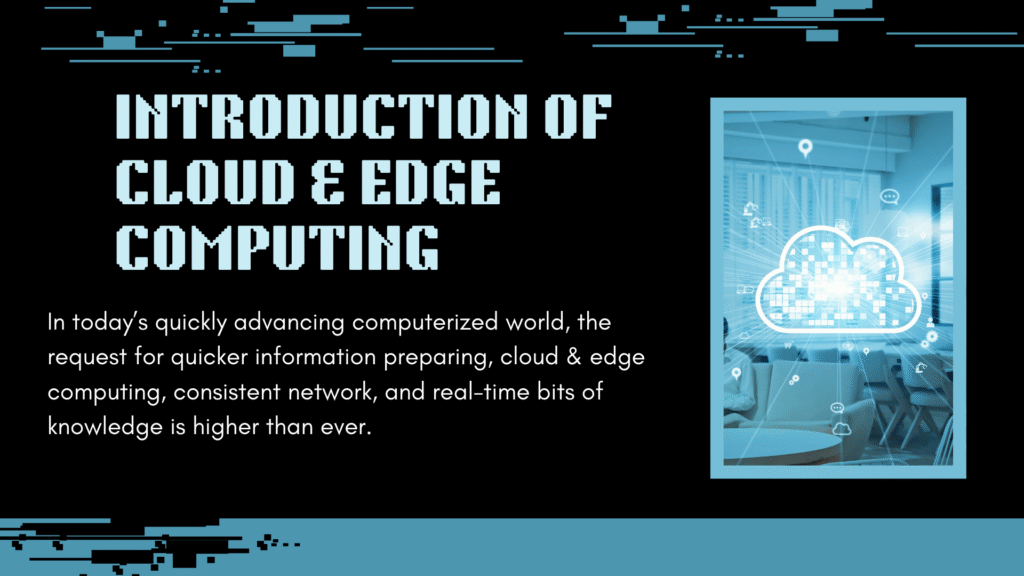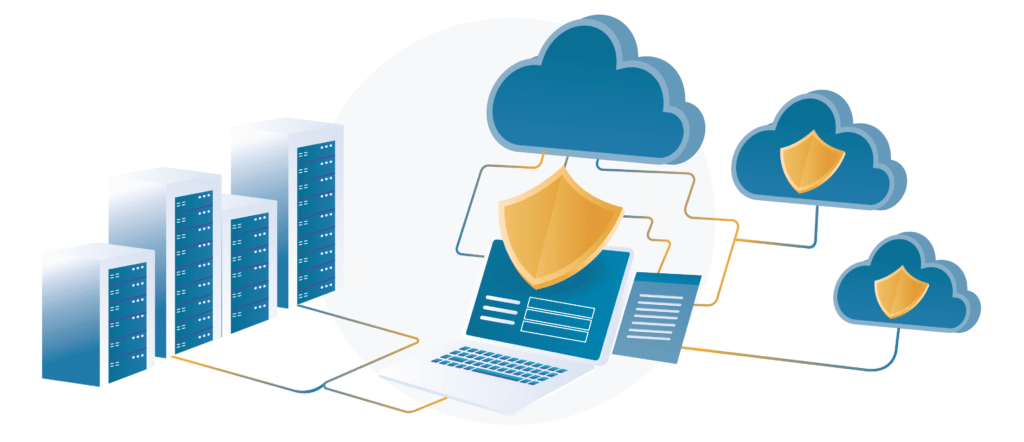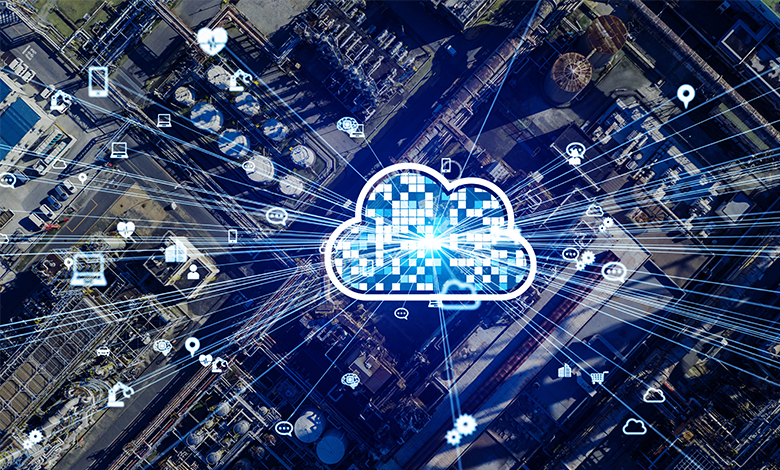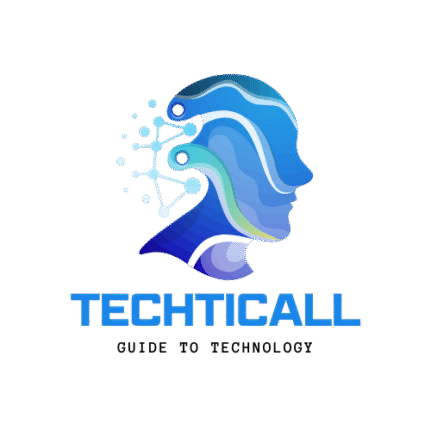Introduction:
In today’s quickly advancing computerized world, the request for quicker information preparing, cloud & edge computing, consistent network, and real-time bits of knowledge is higher than ever. Businesses, governments, and people depend on innovation not as it were for comfort but moreover for basic decision-making. Whereas cloud computing has as of now built up itself as a prevailing constrain in information capacity and preparing, edge computing brings a modern measurement by empowering information to be handled closer to the source. Together, they are reclassifying how organizations approach adaptability, effectiveness, and security in the advanced age.

What is Cloud Computing?
Cloud & Edge Computing is the conveyance of computing administrations over the web, permitting businesses and people to get to capacity, applications, and handling control without owning costly equipment. Instep of keeping up nearby servers or individual gadgets with tall handling capabilities, clients can use capable cloud servers found worldwide.
The cloud show is based on three fundamental benefit types:
- IaaS (Foundation as a Benefit): Gives virtualized computing assets like capacity and servers.
- SaaS (Program as a Benefit): Conveys computer program applications over the web, open on-demand, such as Google Workspace, Salesforce, or Microsoft 365.
Cloud computing is well known since it is cost-efficient, versatile, and open universally. It kills the require for forthright speculation in IT framework whereas guaranteeing businesses can develop easily as request increases.
What is Edge Computing?
Instead of sending crude information to a far off cloud information center, cloud & edge computing permits nearby preparing. This diminishes idleness, spares transmission capacity, and guarantees speedier decision-making. For occurrence, in self-driving cars, edge computing permits the vehicle to analyze real-time activity conditions without holding up for a cloud server’s response.
Key benefits of edge computing include:
- Reduced inactivity: Quicker information preparing due to proximity.
- Improved transmission capacity proficiency: Less information needs to travel long distances.
- Enhanced security: Delicate information can stay inside nearby networks.
(Cloud vs. Edge Computing) Key Contrasts:
They work differently:
| Aspect | Cloud Computing | Edge Computing |
| Location | Centralized information centers over the globe | Near or at the information source (IoT gadgets, sensors) |
| Latency | Higher due to distance between user and cloud server | Extremely low, as processing is local |
| Scalability | Highly scalable with global infrastructure | Limited scalability, device specific |
| Security | Vulnerable to external breaches, but highly regulated | Enhanced by keeping data local, but harder to manage |
| Use Cases | Big data analytics, SaaS application storage | Autonomous vehicles,AR/VR, industrial loT |
Latency Higher due to remove between client and cloud server Extremely moo, as handling is local
Scalability Highly versatile with worldwide infrastructure Limited versatility, device-specific
Security Vulnerable to outside breaches, but exceedingly regulated Enhanced by keeping information nearby, but harder to manage
Use Cases Big information analytics, SaaS applications, storage Autonomous vehicles, AR/VR, mechanical IoT.
How Cloud and Edge Computing Work Together?
Businesses frequently send a cross breed show that leverages both. For case, IoT sensors may collect information and handle it at the edge for prompt reaction, but too send summarized bits of knowledge to the cloud for long-term investigation and storage.
This cooperative energy ensures:
- Faster decision-making: Edge handles moment needs.
- Cost effectiveness: Cloud oversees bulk storage.
- Reliability: Repetition over frameworks diminishes risks.
A real-world illustration is keen cities. Activity lights may depend on edge computing to alter signals in genuine time, whereas the cloud stores activity designs for future urban planning.

Benefits of Cloud & Edge Computing for Businesses:
- Scalability & Adaptability – Businesses can scale up right away through cloud framework, whereas edge gadgets optimize nearby operations.
- Cost Reserve funds – By handling information locally, organizations spare transfer speed costs, whereas cloud diminishes capital use on infrastructure.
- Real-Time Analytics – Edge computing makes split-second choices conceivable, particularly in businesses like healthcare, car, and retail.
- Improved Security – Combining cloud security conventions with edge security upgrades information protection.
Use Cases of Cloud & Edge Computing:
- Healthcare: Inaccessible quiet observing gadgets handle information locally for crises but store records in the cloud.
- Retail: Keen racks identify stock in real-time utilizing edge sensors, whereas cloud frameworks analyze buying patterns.
- Automotive: Independent vehicles depend on edge computing for moment response and cloud administrations for over-the-air updates.
- Manufacturing: Prescient upkeep depends on IoT edge gadgets, with bits of knowledge encouraged into cloud-based AI models.
Challenges in Receiving Cloud & Edge Computing:
While both offer enormous benefits, businesses must moreover address challenges:
- Integration Complexity: Overseeing a crossover cloud-edge framework requires progressed IT expertise.
- Data Security Concerns: In spite of the fact that edge decreases presentation, different endpoints can be difficult to secure.
- Cost of Execution: Edge gadgets and cloud administrations may be costly for little businesses initially.
- Standardization Issues: Need of all inclusive measures complicates cross-platform interoperability.
Future of Cloud & Edge Computing:
The future will be driven by a combination of both innovations, particularly with the rise of AI, 5G, and IoT. By 2030, specialists foresee trillions of associated gadgets that will depend intensely on edge computing, whereas cloud framework will proceed to oversee information capacity and analytics at scale.
We will likely see:
- Decentralized Cloud Models: Cloud suppliers making smaller scale information centers closer to users.
- Stronger Security Systems: Cross breed models with progressed encryption and compliance standards.
Businesses that grasp this merging early will remain ahead in the advanced race.

Conclusion:
Cloud and edge computing are not competitors but vital accomplices in forming the future of innovation.While cloud computing offers flexibility, sensibility, and around the world reach, edge computing passes on speed, capability, and real-time responsiveness. Together, they lock in businesses, governments, and individuals to handle data in more brilliant, speedier, and more secure ways. The future of computerized framework lies in striking the idealize adjust between these two powerhouses.
FAQs
1.Is edge computing supplanting cloud computing?
No, edge computing complements cloud computing by taking care of real-time preparing locally whereas cloud oversees capacity and analytics.
2.What businesses advantage most from edge computing?
Industries like healthcare, car, fabricating, and broadcast communications pick up the most due to their dependence on real-time data.
3.How does edge computing move forward security?
By keeping delicate information near to its source, edge computing diminishes dangers of introduction amid transmission to centralized servers.
4.Can little businesses utilize edge computing?
Yes, but selection may require speculation in IoT gadgets and specialized IT back. Numerous cloud suppliers presently offer cost-effective edge arrangements for SMEs.
